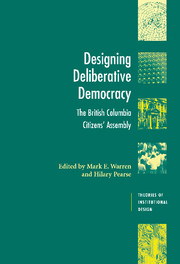Book contents
- Frontmatter
- Contents
- List of Tables
- List of Figures
- Contributors
- Preface
- Introduction: democratic renewal and deliberative democracy
- 1 Who should govern who governs? The role of citizens in reforming the electoral system
- 2 Citizen representatives
- 3 Institutional design and citizen deliberation
- 4 Agenda-setting in deliberative forums: expert influence and citizen autonomy in the British Columbia Citizens' Assembly
- 5 Descriptive representation in the British Columbia Citizens' Assembly
- 6 Do citizens' assemblies make reasoned choices?
- 7 Communicative rationality in the Citizens' Assembly and referendum processes
- 8 Deliberation, information, and trust: the British Columbia Citizens' Assembly as agenda setter
- Conclusion: the Citizens' Assembly model
- References
- Index
5 - Descriptive representation in the British Columbia Citizens' Assembly
Published online by Cambridge University Press: 22 September 2009
- Frontmatter
- Contents
- List of Tables
- List of Figures
- Contributors
- Preface
- Introduction: democratic renewal and deliberative democracy
- 1 Who should govern who governs? The role of citizens in reforming the electoral system
- 2 Citizen representatives
- 3 Institutional design and citizen deliberation
- 4 Agenda-setting in deliberative forums: expert influence and citizen autonomy in the British Columbia Citizens' Assembly
- 5 Descriptive representation in the British Columbia Citizens' Assembly
- 6 Do citizens' assemblies make reasoned choices?
- 7 Communicative rationality in the Citizens' Assembly and referendum processes
- 8 Deliberation, information, and trust: the British Columbia Citizens' Assembly as agenda setter
- Conclusion: the Citizens' Assembly model
- References
- Index
Summary
The last decade has seen a marked interest in deliberative citizen assemblies. Ideally, such bodies allow ordinary citizens to engage in rational deliberation over pressing political issues. However, they often lack significant influence on policymaking or electoral politics, a criticism leveled at James Fishkin's National Issues Convention (Fishkin 1995; Gastil 2000: 131, 135). The British Columbia Citizens' Assembly on Electoral Reform (CA) is an important institutional innovation precisely because it exercised considerable political influence. Its participants judged which electoral system would best suit the Province of British Columbia, whose citizens could then accept or reject the recommended system in a provincial referendum.
In doing so, the CA engaged in two forms of political influence. First, they set the agenda for a binding, province-wide referendum, by voting to select a modified version of the single transferable vote (STV; see page 130) over the German-style mixed member proportional representation system (MMP; see page 130). In choosing STV, the Assembly did not make a binding decision for the province. But because their choice was to be ratified through a Yes or No vote, they set a very narrow agenda for the BC electorate, and agenda-setting is a pretty significant form of political power (Dahl 1989: 112–14; Riker 1982). But beyond agenda-setting, participants in the CA also exercised political influence in recommending the STV to the broader BC populace. On a micro-level, individual participants tried to persuade their fellow citizens that the STV was the best system for the province.
- Type
- Chapter
- Information
- Designing Deliberative DemocracyThe British Columbia Citizens' Assembly, pp. 106 - 126Publisher: Cambridge University PressPrint publication year: 2008
- 11
- Cited by



